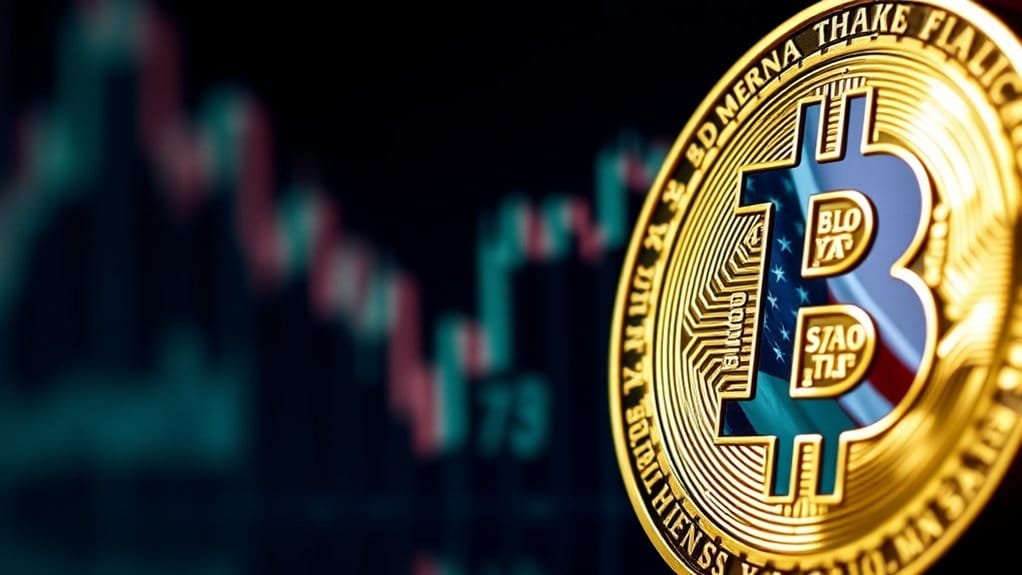Bitcoin hovers around $82,600 today, a critical level as traders digest Trump’s proposed tariffs. Market volatility persists despite reduced trading volumes, dropping from $50 billion to $35 billion since January. Technical indicators show mixed signals—some suggest oversold conditions while others point to continued bearish trends. Interest rates and regulatory uncertainty add to the market’s jitters. Long-term projections remain ambitious despite short-term turbulence. The bigger economic landscape might surprise you.

As global markets continue their unpredictable dance, Bitcoin now sits pretty at approximately $82,600. That’s right, folks—the world’s leading cryptocurrency is testing new waters as March 2025 draws to a close. Traders are watching with bated breath. Some excited, others terrified. The usual crypto rollercoaster.
The initial quarter of 2025 hasn’t been a smooth ride for Bitcoin enthusiasts. Volatility? You bet. The digital currency has been swinging wildly, leaving investors clutching their metaphorical seats. Trading volumes are down, too. Less action, more caution. Can’t blame them. The decline in Bitcoin’s trading volume from $50 billion to $35 billion since January reflects this cautious sentiment.
Economic factors are playing their part in this crypto drama. Rising interest rates have put pressure on risk assets across the board. And then there’s the regulatory uncertainty. Governments can’t decide if they love crypto or hate it. They’re probably just jealous they didn’t buy in earlier.
Trump’s tariff proposals aren’t helping matters. Global economic policies shift, Bitcoin reacts. It’s simple cause and effect, really. The market doesn’t exist in a vacuum—shocking, I know.
Despite the current jitters, some analysts remain optimistic about Bitcoin’s path. Long-term projections suggest the cryptocurrency could hit the mythical $1 million mark by the mid-2030s. According to the Bitcoin Power Law model that has accurately tracked price movements for over 15 years, this target remains feasible despite the current market uncertainty. Ambitious? Maybe. Impossible? We’ve seen crazier things happen.
Technical indicators tell their own story. Low RSI readings hint at oversold conditions, potentially signaling a rebound. But MACD crossovers suggest the bears might not be done yet. It’s a mixed bag of signals.
From its nebulous beginnings to today’s $82,597.59 price tag, Bitcoin has weathered numerous storms. The reduced exchange supply has created a potential scarcity effect that many analysts believe could trigger significant price action in the coming months. The cryptocurrency has demonstrated extraordinary resilience over the years.
For now, the market holds its breath. Will Bitcoin break through resistance levels? Will regulatory clarity emerge? Will tariffs reshape global crypto markets? Questions abound. Answers? Those are in shorter supply. Welcome to crypto in 2025—same unpredictability, higher stakes.
Frequently Asked Questions
How Will Trump’s Tariffs Impact Cryptocurrency Mining Operations?
Trump’s tariffs will hammer crypto mining operations.
Equipment costs? Way up.
Chinese ASIC miners and GPUs? More expensive.
Smaller miners might fold completely.
The customs nightmare is real too—delays and holding fees eating into profits.
Some operations are eyeing relocation to friendlier countries.
Canada’s retaliatory tariffs don’t help either.
The big players will survive, obviously.
The little guys? They’re screwed.
Mining power consolidation seems inevitable.
Are Institutional Investors Flocking to Bitcoin More Than Altcoins Now?
Institutional investors still favor Bitcoin and Ethereum, but they’re diversifying.
Data shows XRP and SOL are the most popular altcoins among institutions.
Sure, BTC dominates, but 68% of investors are eyeing altcoin ETFs.
Regulatory clarity matters – a lot.
As markets improve, expect more altcoin interest.
Meanwhile, 83% of institutions plan to enhance crypto allocations in 2025.
Bitcoin initially, altcoins second.
That’s just how it works.
What Role Does ETF Inflow Play in Recent Price Movements?
ETF inflows have definitely moved Bitcoin’s needle recently. Over $4.4 billion poured in during a short window, showing serious institutional appetite.
But it’s complicated. Those inflows don’t guarantee sustained price jumps. Case in point: the $196.4 million influx in late March was followed by outflows.
BlackRock’s IBIT keeps winning while Grayscale’s GBTC bleeds money.
Bottom line? ETFs matter, but they’re just one piece of Bitcoin’s wild price puzzle.
Could Bitcoin Replace Gold as an Inflation Hedge Completely?
Bitcoin could replace gold partially, not completely. The digital asset lacks gold’s millennia-long track record.
Gold’s physical properties remain superior during internet outages or tech failures. Plus, institutions still prefer gold’s stability.
Bitcoin’s volatility – sometimes crazy swings overnight – makes it unreliable as a pure inflation hedge.
That said, Bitcoin’s scarcity and portability advantages are real. Both assets will likely coexist as inflation hedges for decades.
How Might Bitcoin Adoption Change Under a Second Trump Administration?
Bitcoin adoption could skyrocket under Trump 2.0. His pro-crypto rhetoric promises to make “USA a crypto superpower” – not just talk.
Regulatory clarity might ultimately emerge after years of confusion. Wall Street’s already warming up with those ETFs.
Bitcoin’s already seeing 28% ownership among Americans. Institutional money? Pouring in.
The global impact could be massive. Trump’s business-friendly policies and potential tax reforms might just turbocharge what’s already happening.
Get ready.

